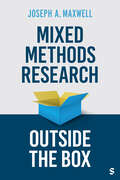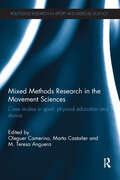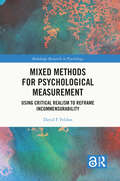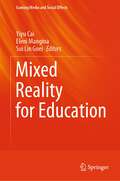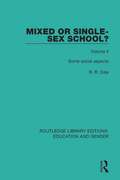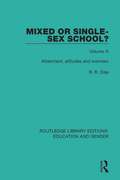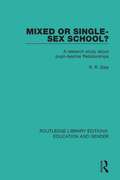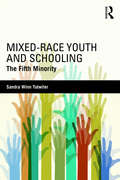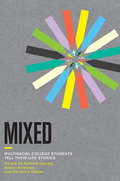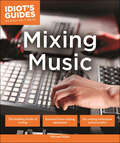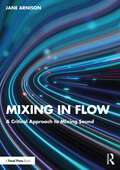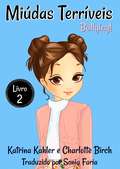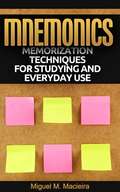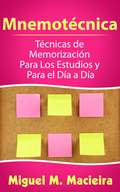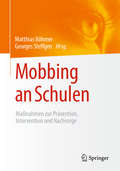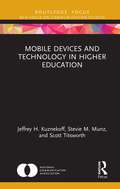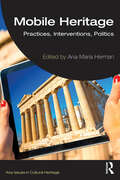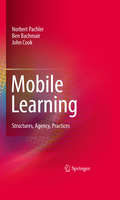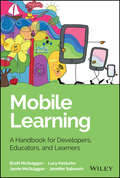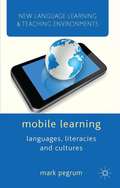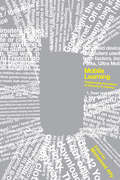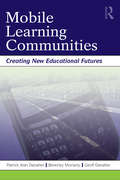- Table View
- List View
Mixed Methods Research Outside the Box
by Joseph A. Maxwell Inc. Sage PublicationsIn Mixed Methods Research Outside the Box, Joseph A. Maxwell shows readers how to carry out unconventional, yet effective, mixed methods research. Providing a new way to think about and combine qualitative and quantitative research, this readable text takes a broad view of mixed methods, revealing the largely unrecognized early history of mixed methods research and its current diversity across disciplines. Maxwell brings together work on combining qualitative and quantitative methods from a variety of disciplines and puts them in conversation with one another. He identifies mixed methods’ philosophical bases, presenting an "interactive" model of design that more closely integrates qualitative and quantitative elements and emphasizes the complementarity of qualitative and quantitative methods for understanding causation and generalization. Drawing from recent works on causation, integration, and philosophy of science, this text promotes innovations in mixed methods, such as process tracing in political science and design-based research in education. This groundbreaking book provides readers with a new way of thinking about, developing, and conducting mixed methods research.
Mixed Methods Research Outside the Box
by Joseph A. Maxwell Inc. Sage PublicationsIn Mixed Methods Research Outside the Box, Joseph A. Maxwell shows readers how to carry out unconventional, yet effective, mixed methods research. Providing a new way to think about and combine qualitative and quantitative research, this readable text takes a broad view of mixed methods, revealing the largely unrecognized early history of mixed methods research and its current diversity across disciplines. Maxwell brings together work on combining qualitative and quantitative methods from a variety of disciplines and puts them in conversation with one another. He identifies mixed methods’ philosophical bases, presenting an "interactive" model of design that more closely integrates qualitative and quantitative elements and emphasizes the complementarity of qualitative and quantitative methods for understanding causation and generalization. Drawing from recent works on causation, integration, and philosophy of science, this text promotes innovations in mixed methods, such as process tracing in political science and design-based research in education. This groundbreaking book provides readers with a new way of thinking about, developing, and conducting mixed methods research.
Mixed Methods Research in the Movement Sciences: Case Studies in Sport, Physical Education and Dance (Routledge Research in Sport and Exercise Science)
by Oleguer Camerino Marta Castañer M. Teresa AngueraMixed methods research techniques, combining both quantitative and qualitative elements, have become well established throughout the social, behavioural and natural sciences. This is the first book to focus on the application of mixed methods research in the movement sciences, specifically in sport, physical education and dance. Researchers and practitioners in each of these fields are concerned with the study of habitual behaviour in naturalistic contexts, and of the concurrent and sequential nature of events and states, precisely the kind of work that multi-method research design can help illuminate. The book is arranged into four sections. The first provides a thorough overview of mixed methods procedures and research design, and summarizes their applicability to the movement sciences. The remaining sections then offer detailed case studies of mixed methods research in team and individual sports (analyzing hidden patterns of play and optimising technique); kinesics and dance (analyzing motor skills behaviour in childhood, and the complexity of motor responses in dance); and physical education (detecting interaction patterns in group situations, and optimizing non-verbal communication by teachers and sports coaches). Mixed Methods Research in the Movement Sciences offers an important new tool for researchers and helps to close the gap between the analysis of expert performance and our understanding of the general principles of movement science. It is important reading for any student, researcher or professional with an interest in motor control, sport and dance pedagogy, coaching, performance analysis or decision-making in sport.
Mixed Methods for Psychological Measurement: Using Critical Realism to Reframe Incommensurability (Routledge Research in Psychology)
by David F. FeldonThis book presents a groundbreaking approach to measurement from a mixed methodological perspective, reframing the concept of incommensurability to harmonize qualitative and quantitative data in analyses.It draws upon critical realism, latent variable theory, and phenomenography to illustrate how idiographic data can be incorporated into the development and validation of psychological measures. The text delves into foundational methodological assumptions, explores item and instrument validation techniques, and addresses issues of invariance. It further elucidates the application of idiographic strategies in conjunction with differential item function (DIF), item parameter drift (IPD), latent growth models, and the evaluation of measurement models. This innovative framework offers researchers robust tools for integrating diverse data types, enhancing the validity and reliability of their findings, and articulates ways in which these tools can be integrated into critical quantitative perspectives. It is an invaluable resource for anyone seeking to deepen their understanding of mixed methodologies and measurement.It will appeal to scholars, researchers, and students whose goals are to integrate different modes of data, examine alternative perspectives on measurement, and apply new tools to psychological and social research.
Mixed Reality for Education (Gaming Media and Social Effects)
by Yiyu Cai Sui Lin Goei Eleni ManginaThis book consists of chapters that present the state-of-the-art research on mixed reality, simulation and serious games with applications in four main educational topics: (1) K-12 STEAM Education; (2) Tertiary/Professional Education; (3) Special Needs Education; and (4) Cultural, Social & Museum Education. The chapters of the book present a multi-facet view on different approaches to deal with challenges that surround the uptake of educational applications of mixed reality, simulations and serious games in various practices. The different approaches highlight challenges and potential solutions and provide future directions for mixed reality, simulation and serious games research, for the design of learning material and for implementation. By doing so, the book is a useful resource for both students and scholars interested in research in this field, for designers of learning material and for practitioners that want to embrace mixed reality, simulation and/or serious games in their education.Chapter "Development of AR Interactive Components for Positive Behavioral Interventions and Supports" is available open access under a Creative Commons Attribution 4.0 International License via link.springer.com.
Mixed or Single-sex School? Volume 2: Some Social Aspects (Routledge Library Editions: Education and Gender #4)
by R. R. DaleOriginally published in 1971. This second volume in this three-part set examines specific aspects of social relationships within the school and demonstrates that co-educational and single-sex schools are fundamentally different communities. These volumes examine in detail the social and psychosocial differences between co-educational and single-sex schools. This volume provides a wealth of evidence from pupils and ex-pupils about such aspects as discipline, bullying, happiness, anxiety and attitudes to sex.
Mixed or Single-sex School? Volume 3: Attainment, Attitudes and Overview (Routledge Library Editions: Education and Gender #4)
by R. R. DaleOriginally published in 1974. This final volume in the trilogy is concerned primarily with comparing the academic progress made by pupils of near-equal ability in the two types of school. It considers attainment in different subjects but also attitudes to different subjects and then follows up with a study of university students from both types of school background.
Mixed or Single-sex School?: A Research Study in Pupil-Teacher Relationships (Routledge Library Editions: Education and Gender #4)
by R. R. DaleOriginally published in 1969. This is the first volume in a trilogy which compares co-educational and single-sex schools. The study is based on the results of over twenty years’ experience among teachers and pupils and examines in detail the differences between the two types of school. This volume focuses on the teachers and on the pupil-teacher relationship.
Mixed-Race Youth and Schooling: The Fifth Minority
by Sandra Winn TutwilerThis timely, in-depth examination of the educational experiences and needs of mixed-race children ("the fifth minority") focuses on the four contexts that primarily influence learning and development: the family, school, community, and society-at-large. The book provides foundational historical, social, political, and psychological information about mixed-race children and looks closely at their experiences in schools, their identity formation, and how schools can be made more supportive of their development and learning needs. Moving away from an essentialist discussion of mixed-race children, a wide variety of research is included. Life and schooling experiences of mixed-raced individuals are profiled throughout the text. Rather than pigeonholing children into a neat box of descriptions or providing readymade prescriptions for educators, Mixed-Race Youth and Schooling offers information and encourages teachers to critically reflect on how it is relevant to and helpful in their teaching/learning contexts.
Mixed: Multiracial College Students Tell Their Life Stories
by Andrew Garrod Robert Kilkenny Christina GómezMixed presents engaging and incisive first-person experiences of what it is like to be multiracial in what is supposedly a postracial world. Bringing together twelve essays by college students who identify themselves as multiracial, this book considers what this identity means in a reality that occasionally resembles the post-racial dream of some and at other times recalls a familiar world of racial and ethnic prejudice. Exploring a wide range of concerns and anxieties, aspirations and ambitions, these young writers, who all attended Dartmouth College, come from a variety of racial, ethnic, and socioeconomic backgrounds. Unlike individuals who define themselves as having one racial identity, these students have lived the complexity of their identity from a very young age. In Mixed, a book that will benefit educators, students, and their families, they eloquently and often passionately reveal how they experience their multiracial identity, how their parents' race or ethnicity shaped their childhoods, and how perceptions of their race have affected their relationships.
Mixing Music (Idiot's Guides)
by Michael MillerIdiot's Guides: Mixing Music breaks down all the complex jargon for beginners and discussing a blend of skillful principles and techniques that anyone can utilize when mixing. It covers all the fundamentals from the various mixing styles, the element of a mix and how to build one, the rules of arrangement, the secrets of equalization and frequencies. This guide is packed full of expert advice and be platform neutral for any home mixer. Also includes: • In-depth review of budget-friendly music equipment and purchasing. • Chock full of tips, tricks, and techniques on perfecting mixes. • Easy-to-comprehend breakdown of terms and techniques that any mixer can master. • The fundamentals of music mixing, breaking the process down so readers understand the basics. • The building blocks of mixing: reverb, blend, size, tone, sustaining sound, delay types and how to calculate them, balancing, and sonic layering. • Reviews of the various mixing styles, rules for arrangement, and all the tips and tricks for adding effects and creating that perfect sound. • An exploration of the current mixing techniques and principles. • In-depth discussion on the essential home recording budget-conscious mixer needs, what equipment to purchase and what to avoid, and whether or not to use freeware.
Mixing in Flow: A Critical Approach to Mixing Sound
by Jane ArnisonMixing in Flow is a focused guide for mix engineers who are familiar with the basics of mixing and now seek greater consistency and refinement in their work. Rather than covering every fundamental aspect of mixing, it picks up where many mixers experience a plateau – when they know the mechanics but struggle with inconsistent or lacklustre results.This book begins by defining the art of mixing, before moving into an intensive bootcamp where readers delve deep into working with the essential tools and developing effective workflows to maximise their potential. Within this framework, special emphasis is placed on ear training and critical engagement with sound. Using a problem-based approach, the focus then shifts to mixing in practice, by exploring common mixing challenges from the perspective of what we hear, with various techniques offered for addressing these sonic issues. The final section covers advanced topics, providing further insights that follow on from the development of core mixing skills.Designed to inspire readers to develop their unique mixing flow and have confidence in their tools, Mixing in Flow is the ideal companion for anyone looking to improve their mixing, including students and aspiring professional engineers, as well as more experienced mixers looking for new inspiration and continued professional development.
Miúdas Terríveis - Livro 2 - Bullying
by Katrina Kahler Sonia FariaRemmy continua a sofrer de bullying por parte de Sandy e dos seus 'vampiros'. Amelia vem em sua ajuda e ensina a Remmy algumas estratégias para lidar com seus agressores. Ela quer contar à mãe o que está a acontecer, mas Sandy manipulou a situação em casa e Remmy acha que não pode sobrecarregar a sua mãe com os seus problemas. As miúdas malvadas continuam a atormentá-la, tramando-a no Facebook e até colocam algo na sua mochila para lhe causar problemas. Por fim, Remmy não aguenta mais e diz à mãe e ao novo padrasto exatamente o que está a acontecer. Para começar... Marcus não acredita em Remmy, até ver as provas. Claro, a reação de Sandy é dramática e totalmente exagerada! Miúdas Terríveis Livro 2 é cheio de drama. Vais adorar ver Remmy crescer como pessoa, ganhar mais confiança e o amor de Charlie e a amizade de Bridget. Então, nem tudo é mau na sua nova vida em Venice Beach. Uma história perfeita para meninas entre os 9 e os 12 anos.
Mmampodi Buka ya Moithuti 10: UBC Contracted
by Ra Sempe Npk Mohapi Njj Gada MS Sekobolo Sp Mofokeng Le Masooa• Makgonatsohle e latetseng CAPS, e ngotswe ke Bangodi ba hlwahlwa. • Makgonatsohle e nang le ditshwantsho le mesebetsi e ngolwang le e etswang, ho thusa hore baithuti ba be le kutlwisiso le bokgoni ba ho sebetsa ka bokgabane bo boholo dithutong tsa bona, • Makgonatsohle e tataisang titjhere, e mmolokelang nako le ho mo thusa hore a be le bokgoni ba ho ruta ha bobebe, hobane e na le mehlala ya mesebetsi e ka kopuwang. • Makgonatsohle e nang le boleng = katleho thutong le dihlahlobong.
Mmampodi Buka ya Moithuti 10: UBC Uncontracted
by Ra Sempe Npk Mohapi Njj Gada MS Sekobolo Sp Mofokeng Le Masooa• Makgonatsohle e latetseng CAPS, e ngotswe ke Bangodi ba hlwahlwa. • Makgonatsohle e nang le ditshwantsho le mesebetsi e ngolwang le e etswang, ho thusa hore baithuti ba be le kutlwisiso le bokgoni ba ho sebetsa ka bokgabane bo boholo dithutong tsa bona, • Makgonatsohle e tataisang titjhere, e mmolokelang nako le ho mo thusa hore a be le bokgoni ba ho ruta ha bobebe, hobane e na le mehlala ya mesebetsi e ka kopuwang. • Makgonatsohle e nang le boleng = katleho thutong le dihlahlobong.
Mnemonics: Memorization Techniques for Studying and Everyday Use
by Miguel M. Macieira Renato Santana dos SantosLearn tips and tricks to memorize Numbers, Names, Formulas, Lists and much more! Nowadays, a good and dependable memory is fundamental. After all, there's a huge amount of information that we must record: person's names, bank passwords, formulas, numbers and letters, to-do lists, grocery lists, and so on. Students must absorb a huge amount of subjects, an overwhelming task. They must know how to use what's between their ears - a brain - in the most productive way. With the aid of memorization techniques brought by Mnemonics, students and test-takers may gain an "unfair advantage" over other candidates. In this tip filled book, the reader will learn the following techniques: - number/rhyme technique - number/shape technique - ABC technique - memorization through music - room visualization technique - mental journey - acronyms - acrostics - visual images and much more! What are you waiting for to unravel the secrets of memorization? Buy it right now!
Mnemotécnica: Técnicas de Memorización Para los Estudios y Para el Día a Día
by Marcela Gutiérrez Bravo Miguel M. MacieiraUna memoria pobre es, sin duda, una gran desventaja para los estudiantes y los profesionales, al final, todos tenemos que recordar una infinidad de información para tener éxito en los estudios o en la carrera. Una buena noticia es que, prácticamente, cualquier persona puede mejorar su memoria a través de ejercicios físicos, de manutención de la salud y, también, de técnicas de memorización. En este libro, hablaremos con más detalles sobre las técnicas de memorización, conocidas, en su conjunto, como mnemotécnica. Es importante notar que la mnemotécnica puede ser usada por cualquiera, independientemente de su edad u ocupación profesional.
Mobbing an Schulen: Maßnahmen zur Prävention, Intervention und Nachsorge
by Matthias Böhmer Georges SteffgenMobbing stellt an Schulen ein weit verbreitetes Problem dar. Dieses Buch liefert zum einen aktuelle Erklärungsansätze für das Phänomen Mobbing an Schulen. Es wird aufgezeigt, dass Mobbing nicht nur zwischen Opfern und Tätern stattfindet, sondern dass in der Regel alle Mitglieder einer Schulklasse beteiligt sein können. Entsprechend wird beschrieben, welche Folgen Mobbing für alle Beteiligte haben kann. Zum anderen werden allgemeine Präventions- und Interventionsansätze beschrieben sowie elf Anti-Mobbing-Programme detailliert vorgestellt. Einen besonderen Fokus richtet das Buch auf Mobbingnachsorgekonzepte sowie praxisbezogene Exkurse von ausgewiesenen Experten.
Mobile Devices and Technology in Higher Education: Considerations for Students, Teachers, and Administrators (NCA Focus on Communication Studies)
by Scott Titsworth Jeffrey H. Kuznekoff Stevie M. MunzThis book examines key issues at the intersection of education and technology by addressing the question that most educators face—how do we use technology to engage students in the learning process and enhance learning? Problematizing the view that technology is the default solution to a host of problems facing education, while also recognizing that technology has an important place in a variety of education levels, the book provides readers with clear insights on technology and learning from a variety of perspectives from communication studies, education, and related disciplines. This volume is an essential read for scholars and teachers working in the area of elementary education. It will also be of interest to academics working in the area of education, postsecondary education, and learning and can be used as an ancillary text in graduate-level seminars.
Mobile Heritage: Practices, Interventions, Politics (Key Issues in Cultural Heritage)
by Ana-Maria HermanMobile Heritage explores how diverse digital technologies (such as apps, GPS, games, social platforms, NFTs, drones, AR, MR and AI, among others) have allowed for new types of mobilities and introduced a novel set of practices, interventions, and politics for heritage collections, archives, exhibitions, entertainment, conservation, management, commerce, education, restitution, activism, and regulation.The volume is not a ‘how to’ book. Instead, it critically examines this emerging landscape and its unsettling of existing relations between heritage and knowledge, value, identity, power, sense of place, community, nationhood, and ownership – thus outlining a new set of issues, implications, and consequences. The volume brings together case studies from around the world and each chapter considers mobility matters associated with tangible and intangible cultural heritage (relating to art, film, music, games, manuscripts, traditional knowledge, architecture, cities, and more) and the involvement of a variety of actors in digital heritage practices and interventions (such as artists, activists, communities, museums, non-profit organisations, educational institutions, enterprises and governmental agencies). The contributors are scholars and practitioners drawing on various disciplines and fields of study, including archaeology, museum studies, media studies, computing, art history, cultural studies, anthropology, gender studies, mobility studies, and law.Mobile Heritage positions mobility as a critical tool for understanding the changing (digital) heritage landscape, making this volume an essential read for students, academics, and practitioners engaged in this area.
Mobile Learning
by Gunther Kress Norbert Pachler Ben Bachmair John CookAs with television and computers before it, today's mobile technology challenges educators to respond and ensure their work is relevant to students. What's changed is that this portable, cross-contextual way of engaging with the world is driving a more proactive approach to learning on the part of young people. The first full-length authored treatment of the relationship between the centrality of technological development in daily life and its potential as a means of education, Mobile Learning charts the rapid emergence of new forms of mass communication and their potential for gathering, shaping, and analyzing information, studying their transformative capability and learning potential in the contexts of school and socio-cultural change. The focus is on mobile/cell phones, PDAs, and to a lesser extent gaming devices and music players, not as "the next new thing" but meaningfully integrated into education, without objectifying the devices or technology itself. And the book fully grounds readers by offering theoretical and conceptual models, an analytical framework for understanding the issues, recommendations for specialized resources, and practical examples of mobile learning in formal as well as informal educational settings, particularly with at-risk students. Among the topics covered: * Core issues in mobile learning * Mobile devices as educational resources * Socioeconomic approaches to mobile learning * Creating situations that promote mobile learning * Ubiquitous mobility and its implications for pedagogy * Bridging the digital divide at the policy level Mobile Learning is a groundbreaking volume, sure to stimulate both discussion and innovation among educational professionals interested in technology in the context of teaching and learning.
Mobile Learning
by Jamie Mcquiggan Lucy Kosturko Jennifer Sabourin Scott McquigganExplore the game-changing technology that allows mobile learning to effectively reach K-12 students Mobile Learning: A Handbook for Developers, Educators and Learners provides research-based foundations for developing, evaluating, and integrating effective mobile learning pedagogy. Twenty-first century students require twenty-first century technology, and mobile devices provide new and effective ways to educate children. But with new technologies come new challenges--therefore, this handbook presents a comprehensive look at mobile learning by synthesizing relevant theories and drawing practical conclusions for developers, educators, and students. Mobile devices--in ways that the laptop, the personal computer, and netbook computers have not--present the opportunity to make learning more engaging, interactive, and available in both traditional classroom settings and informal learning environments. From theory to practice, Mobile Learning explores how mobile devices are different than their technological predecessors, makes the case for developers, teachers, and parents to invest in the technology, and illustrates the many ways in which it is innovative, exciting, and effective in educating K-12 students. Explores how mobile devices can support the needs of students Provides examples, screenshots, graphics, and visualizations to enhance the material presented in the book Provides developers with the background necessary to create the apps their audience requires Presents the case for mobile learning in and out of classrooms as early as preschool Discusses how mobile learning enables better educational opportunities for the visually impaired, students with Autism, and adult learners. If you're a school administrator, teacher, app developer, or parent, this topical book provides a theoretical, well-researched discussion of the pedagogical theory and mobile learning, as well as practical advice in setting up a mobile learning strategy.
Mobile Learning
by Mark PegrumThis book explores the use of mobile devices for teaching and learning language and literacies, investigating the ways in which these technologies open up new educational possibilities. Pegrum builds up a rich picture of contemporary mobile learning and outlines of likely future developments.
Mobile Learning Communities: Creating New Educational Futures
by Geoff Danaher Patrick Alan Danaher Beverley MoriartyMobile Learning Communities explores the diverse ways in which traveling groups experience learning ‘on the run’. This book provides empirical evidence that draws on the authors’ 17 years of continuing research with international occupational Travelers. It engages with themes such as workplace learning, globalization, multiliteracies, and emerging technologies which impinge on the ways mobile groups make sense of themselves as learning communities. International in focus, this book deals with an issue of increasing global significance and shows the complexities of the lives and learning experiences of such mobile cultures and their strategies for earning, learning, and living, thus challenging simplistic and stereotypical images of traveling groups still found in mainstream media and popular culture. Mobile Learning Communities brings together for the first time mobilities and learning communities into a single and comprehensive focus. It provides a detailed analysis of how mobile groups position themselves and how they are positioned by others. This text will appeal to scholars in the field of distance education and educational technology and to researchers in education, cultural studies, and sociology. It will also be of interest to educational instructors, policy-makers, and administrators, as well as teacher educators and pre-service teachers. It paints a vivid picture of the experience of mobility through the words of the mobile learners themselves, but also critiques existing notions of learning and suggests ways of creating new educational futures for all learners and educators.
